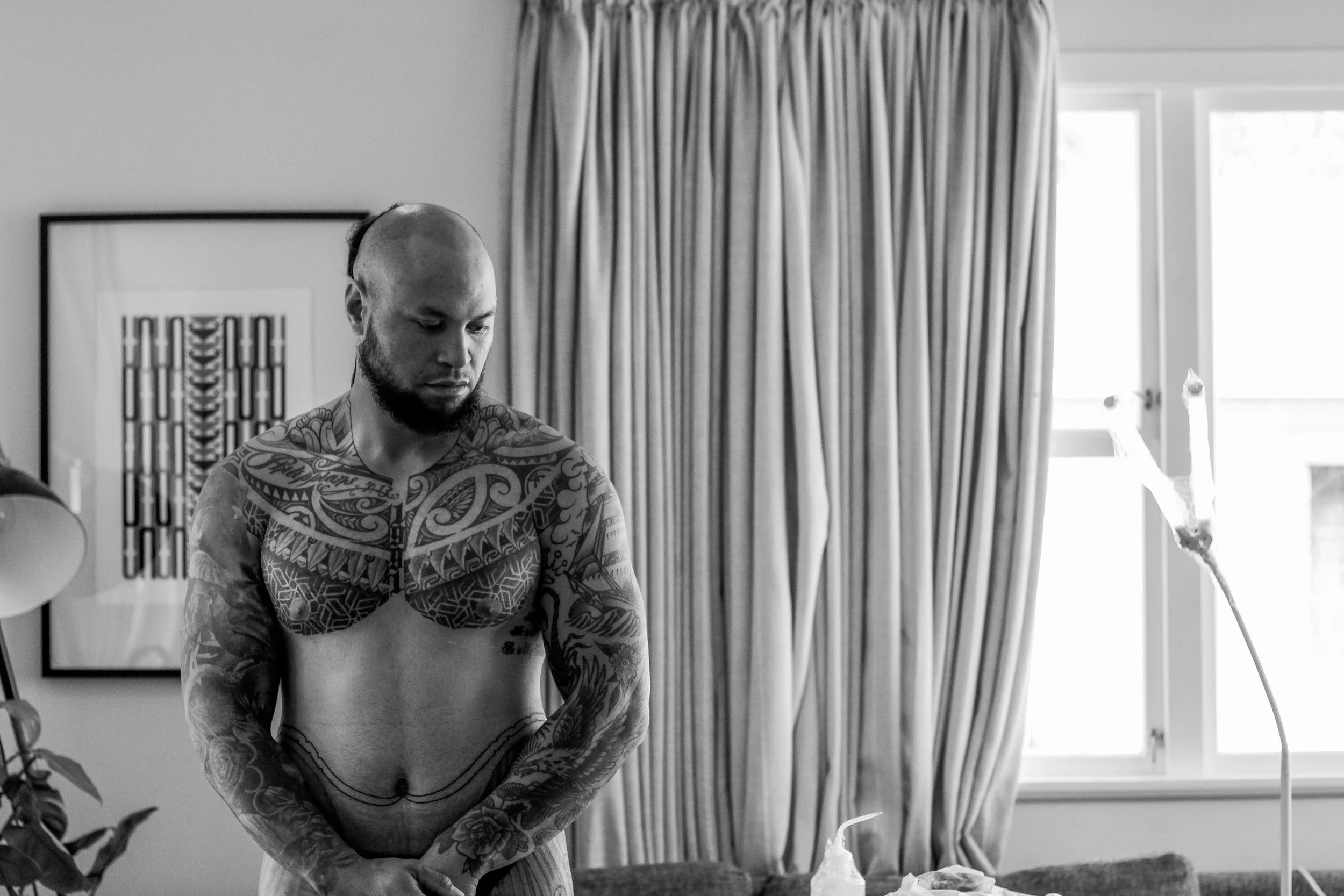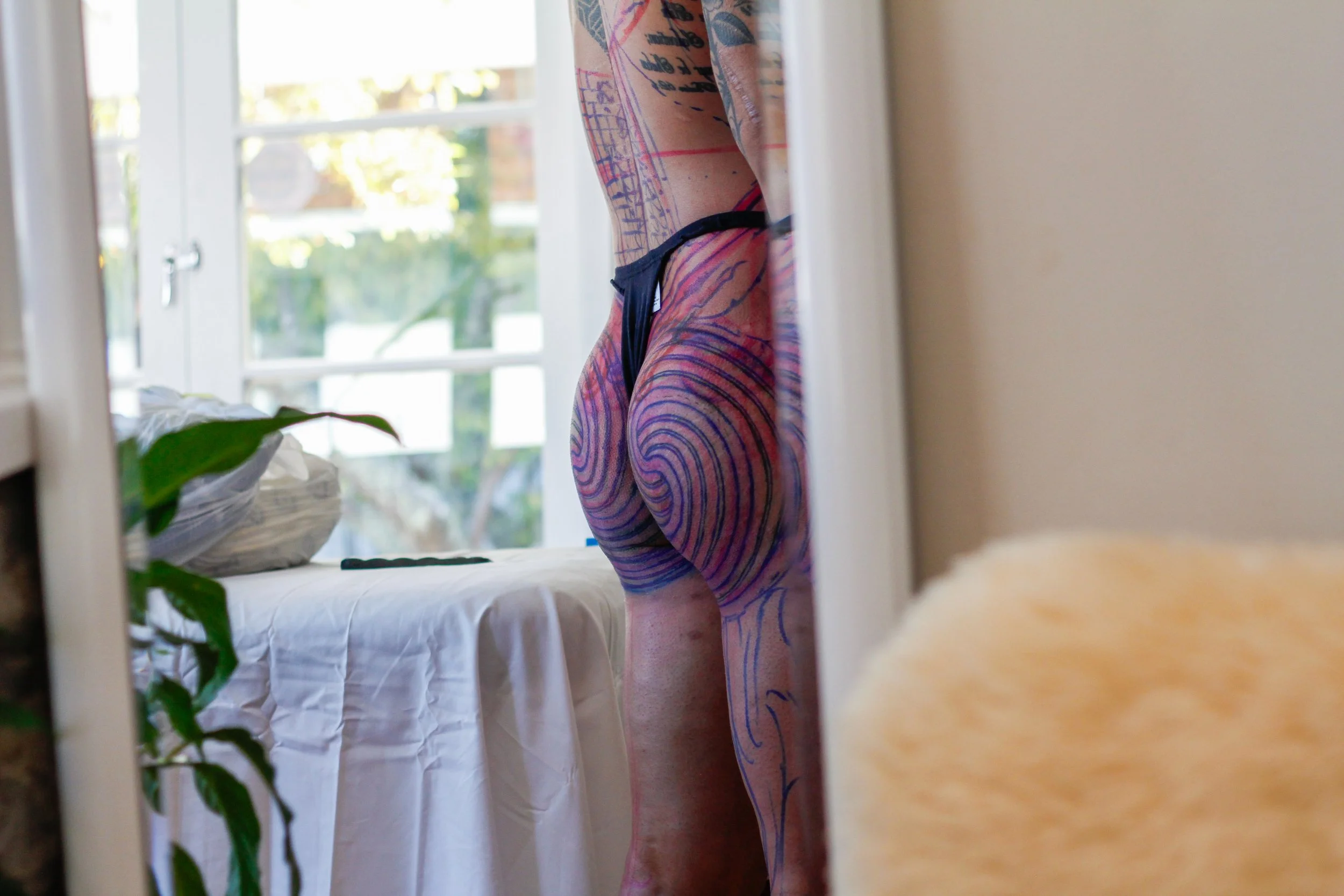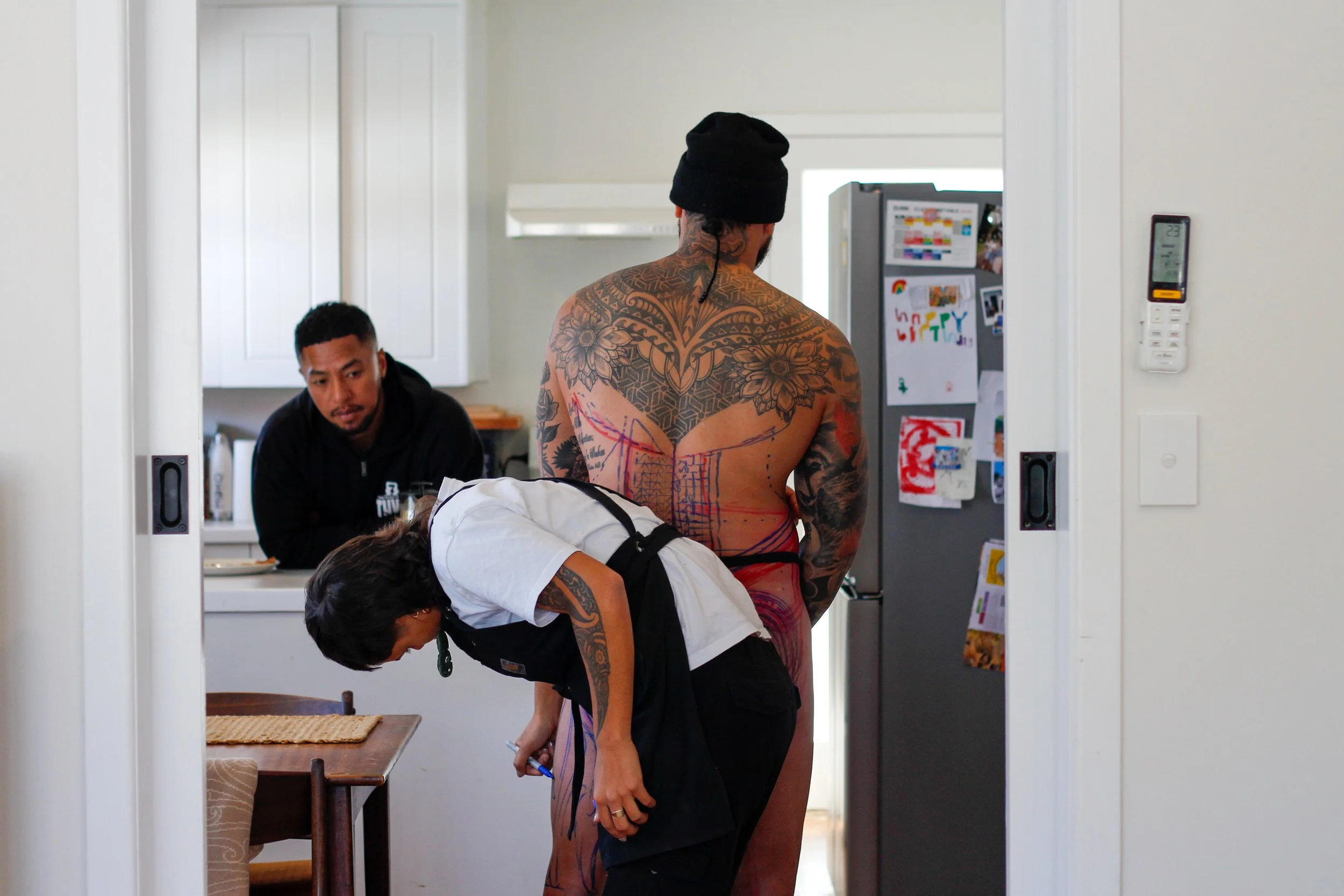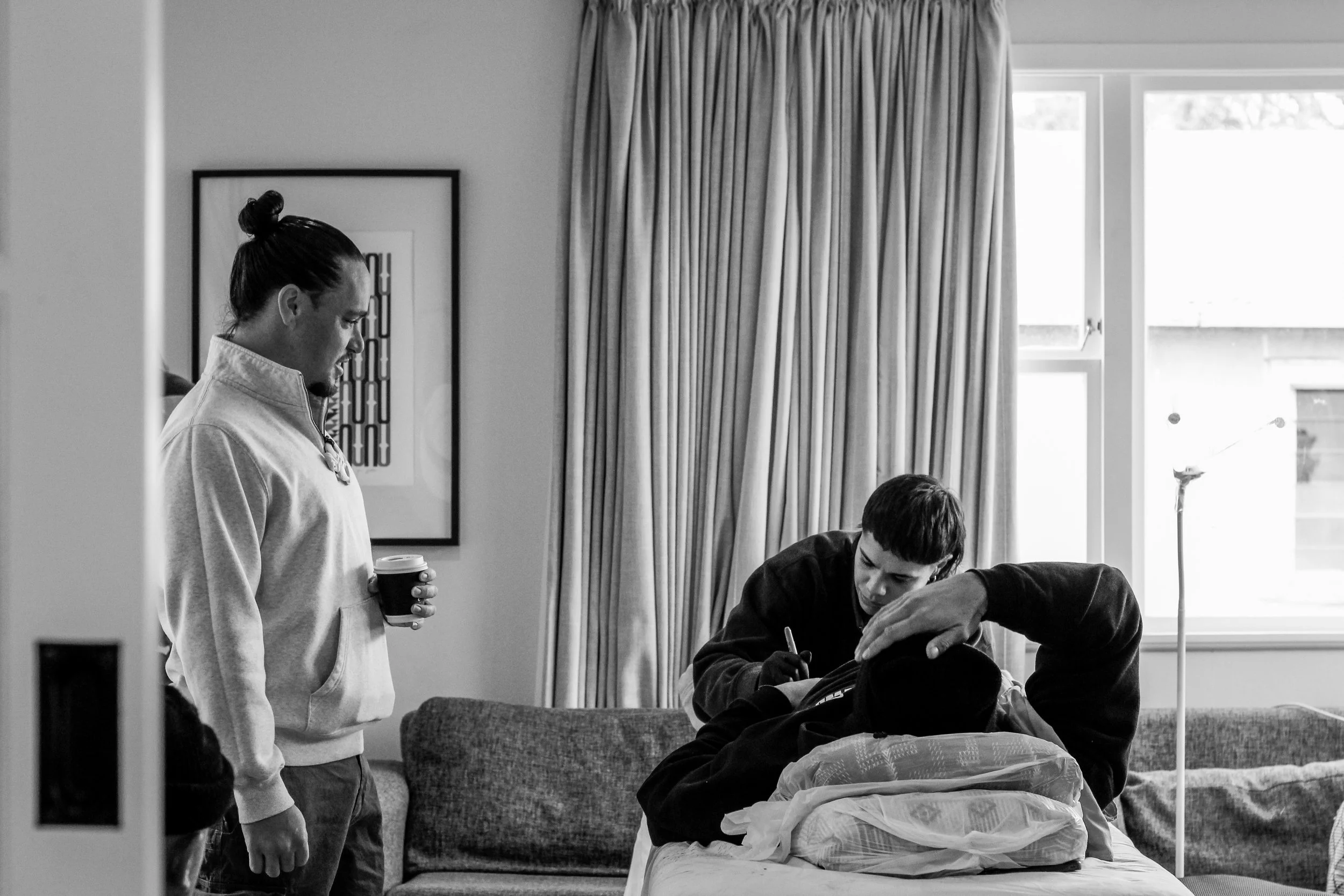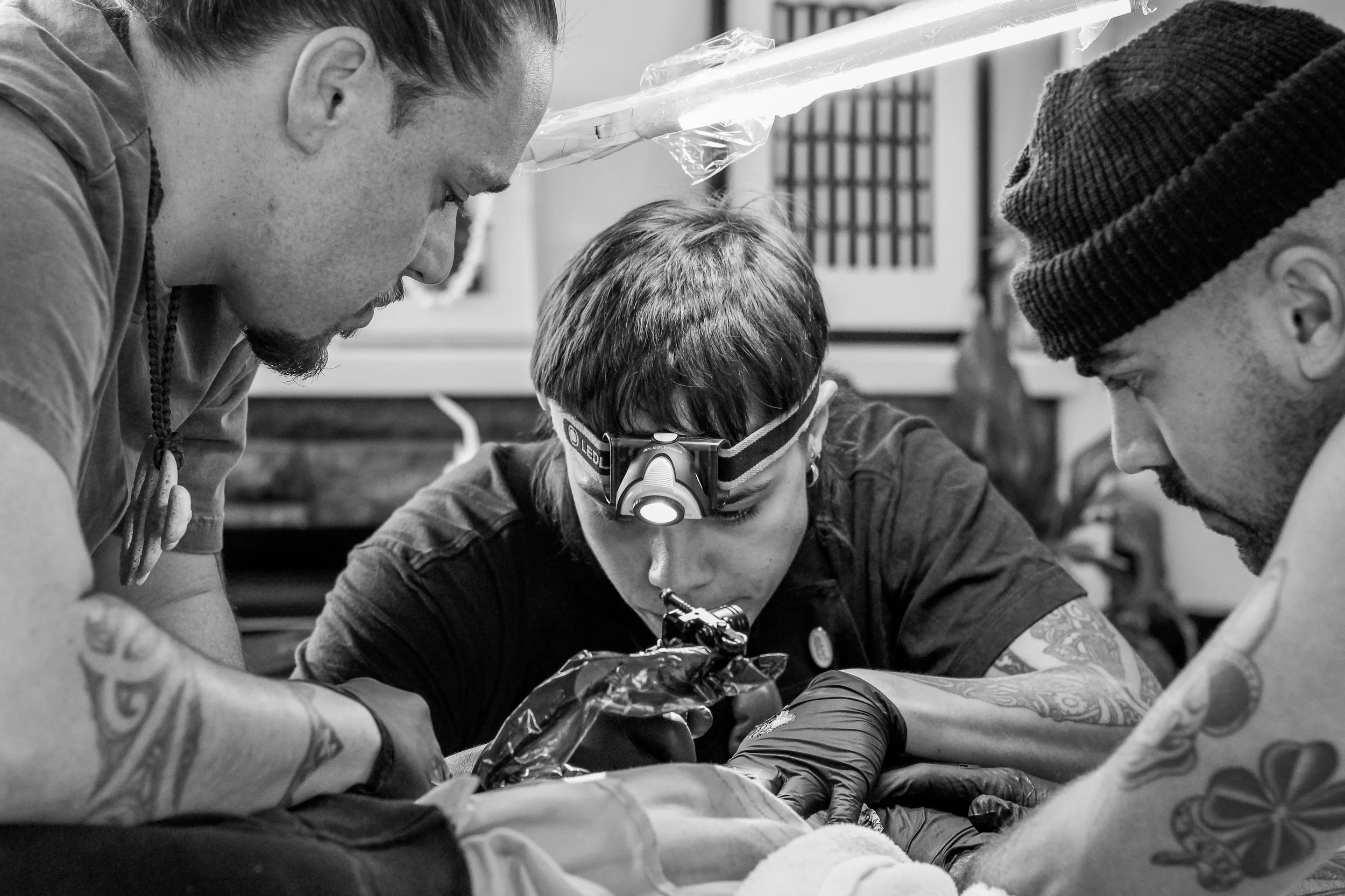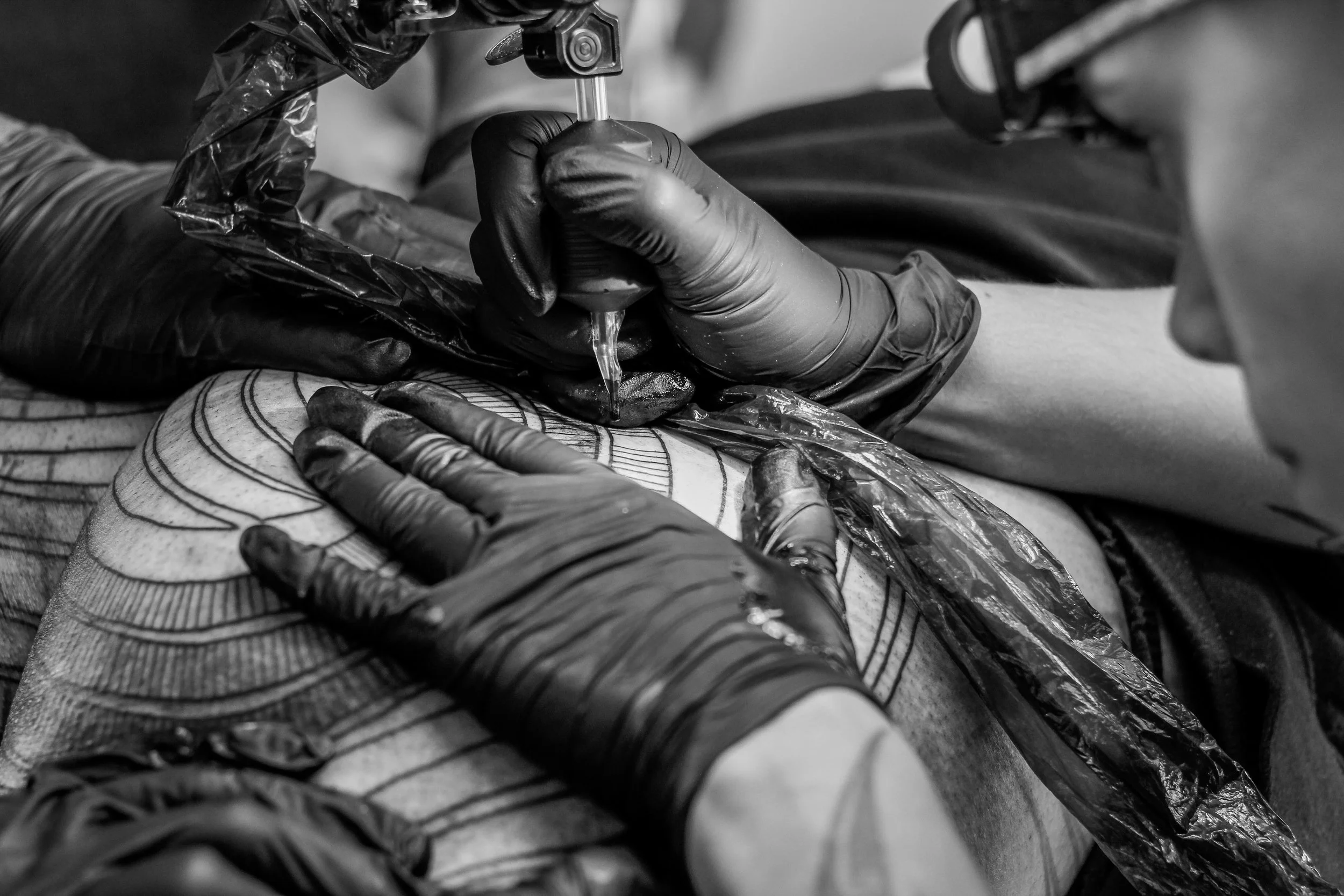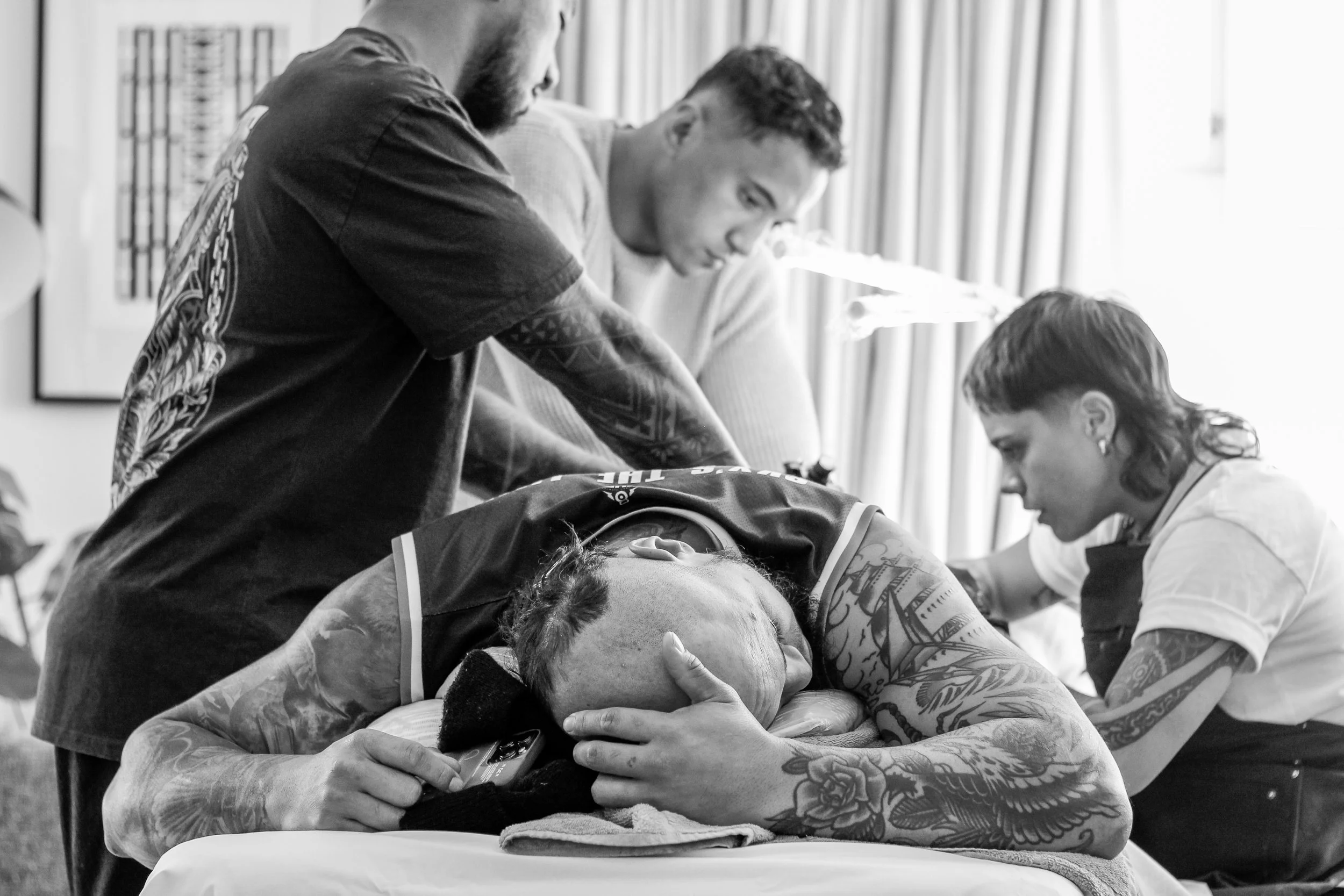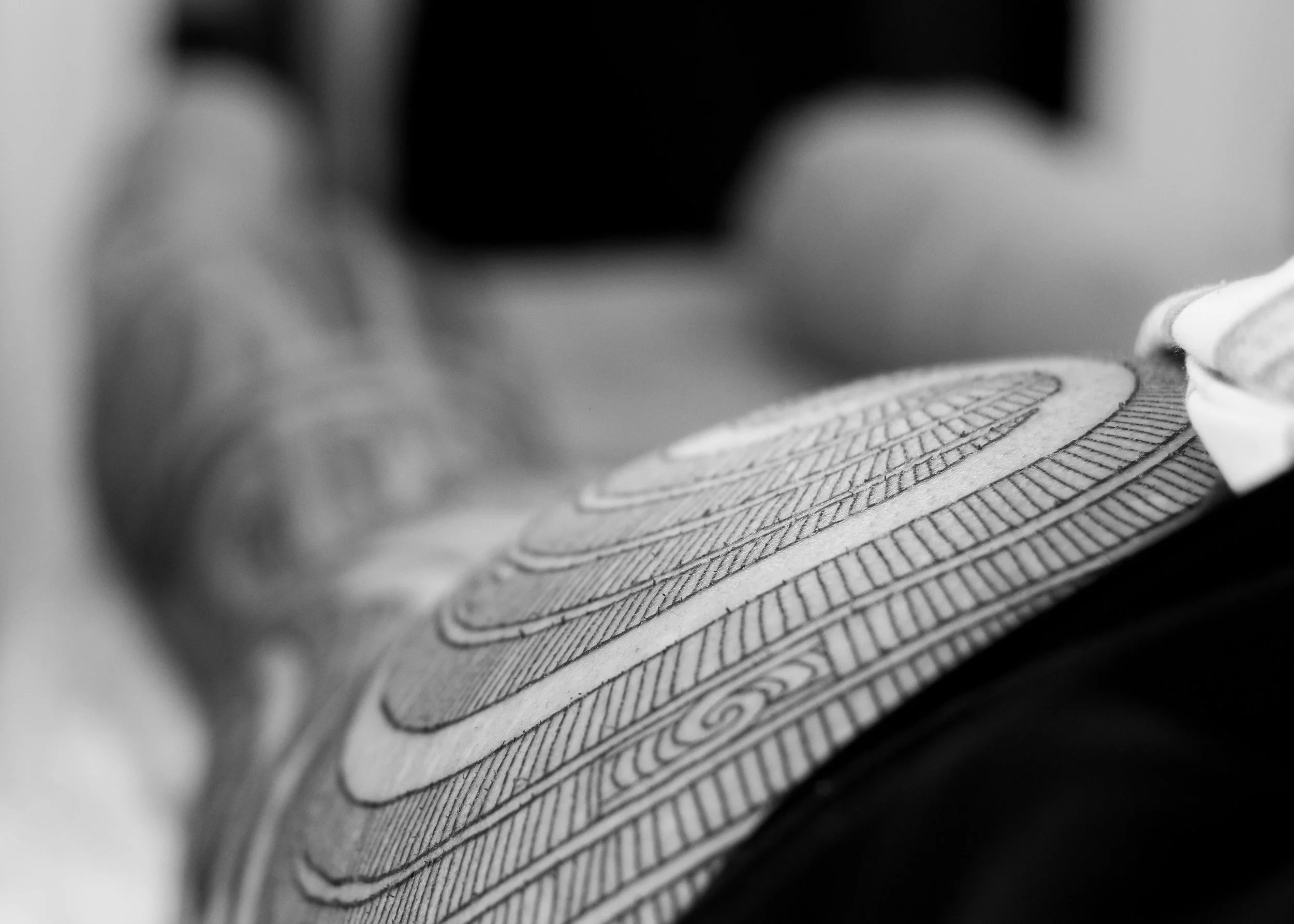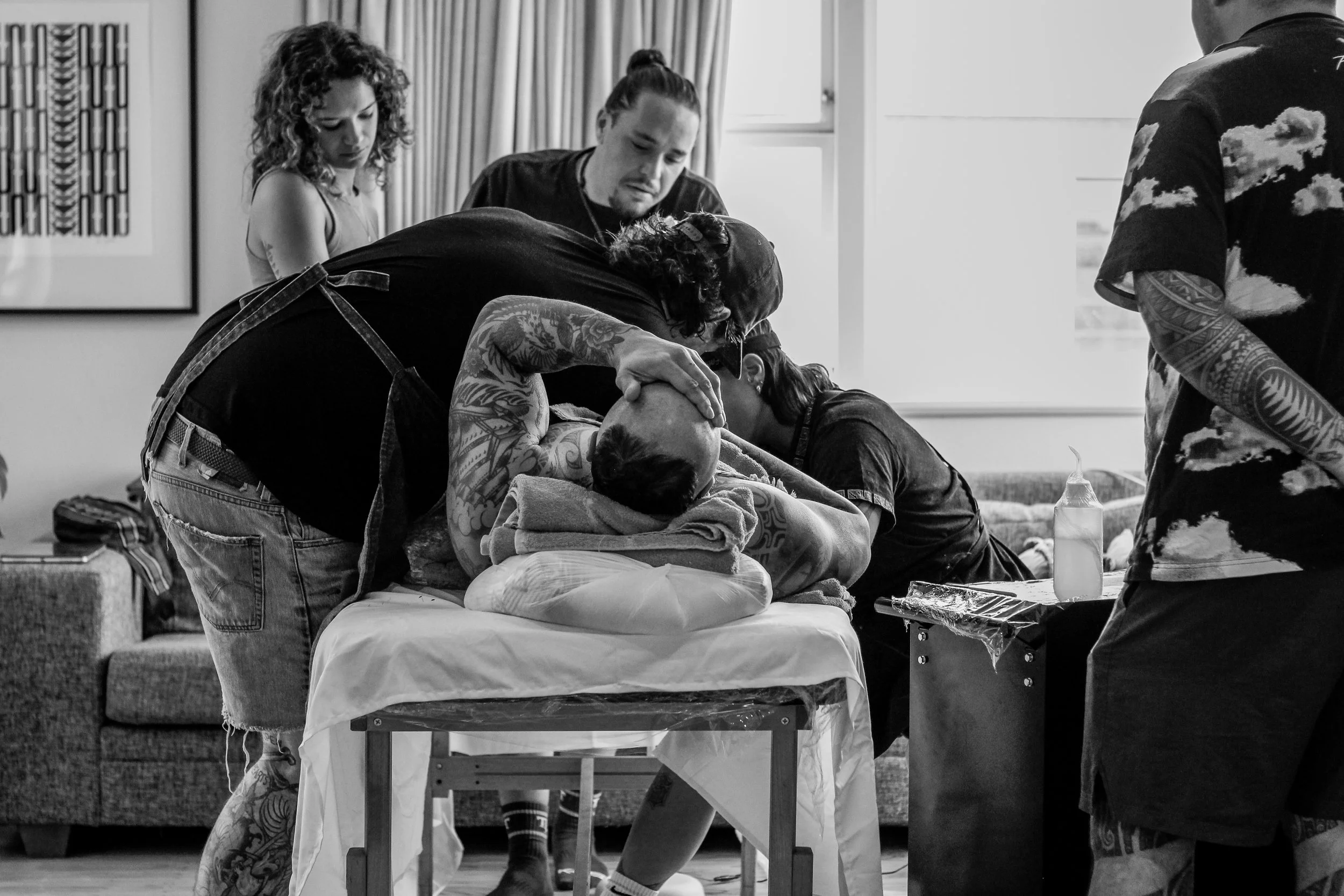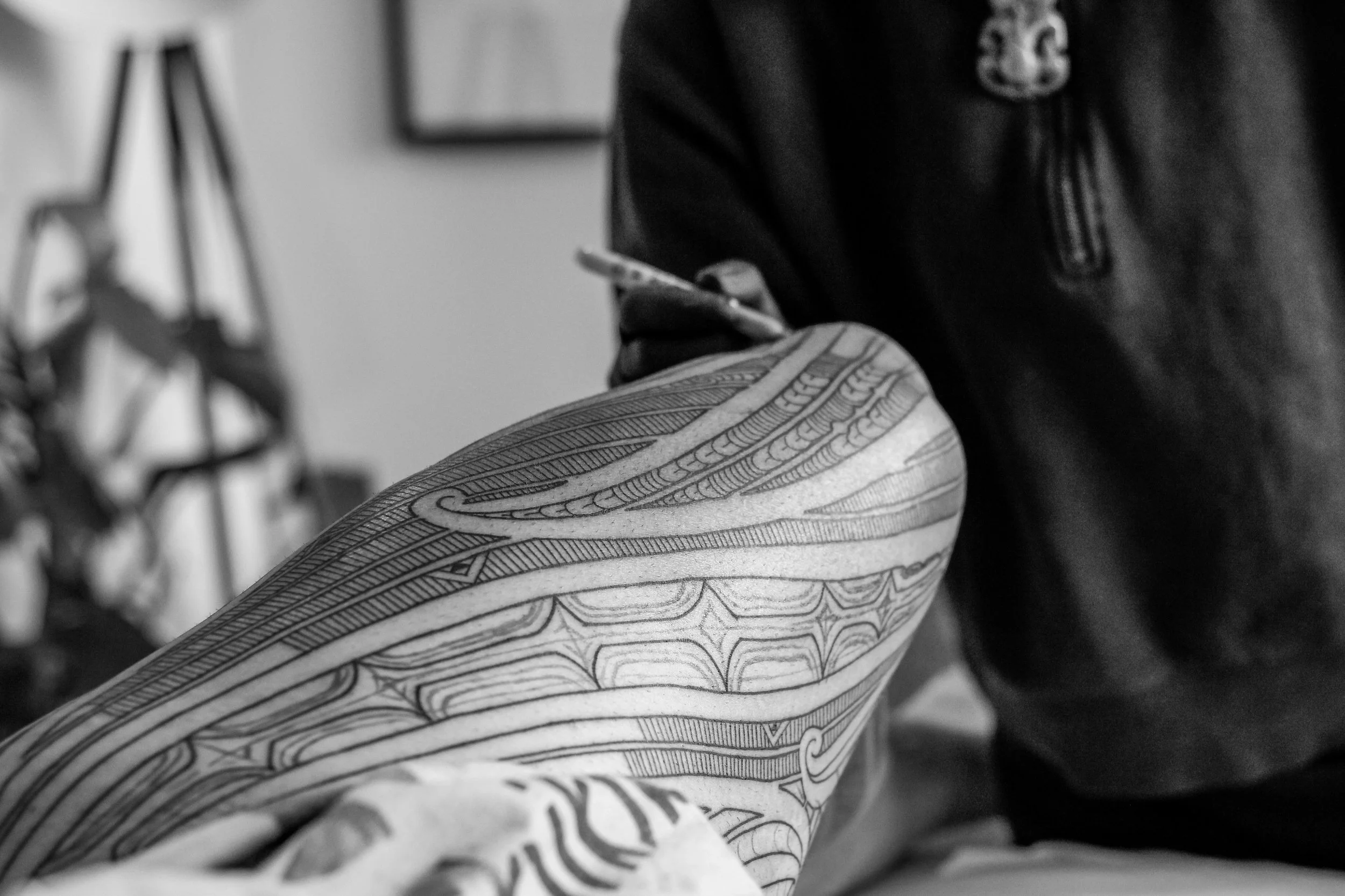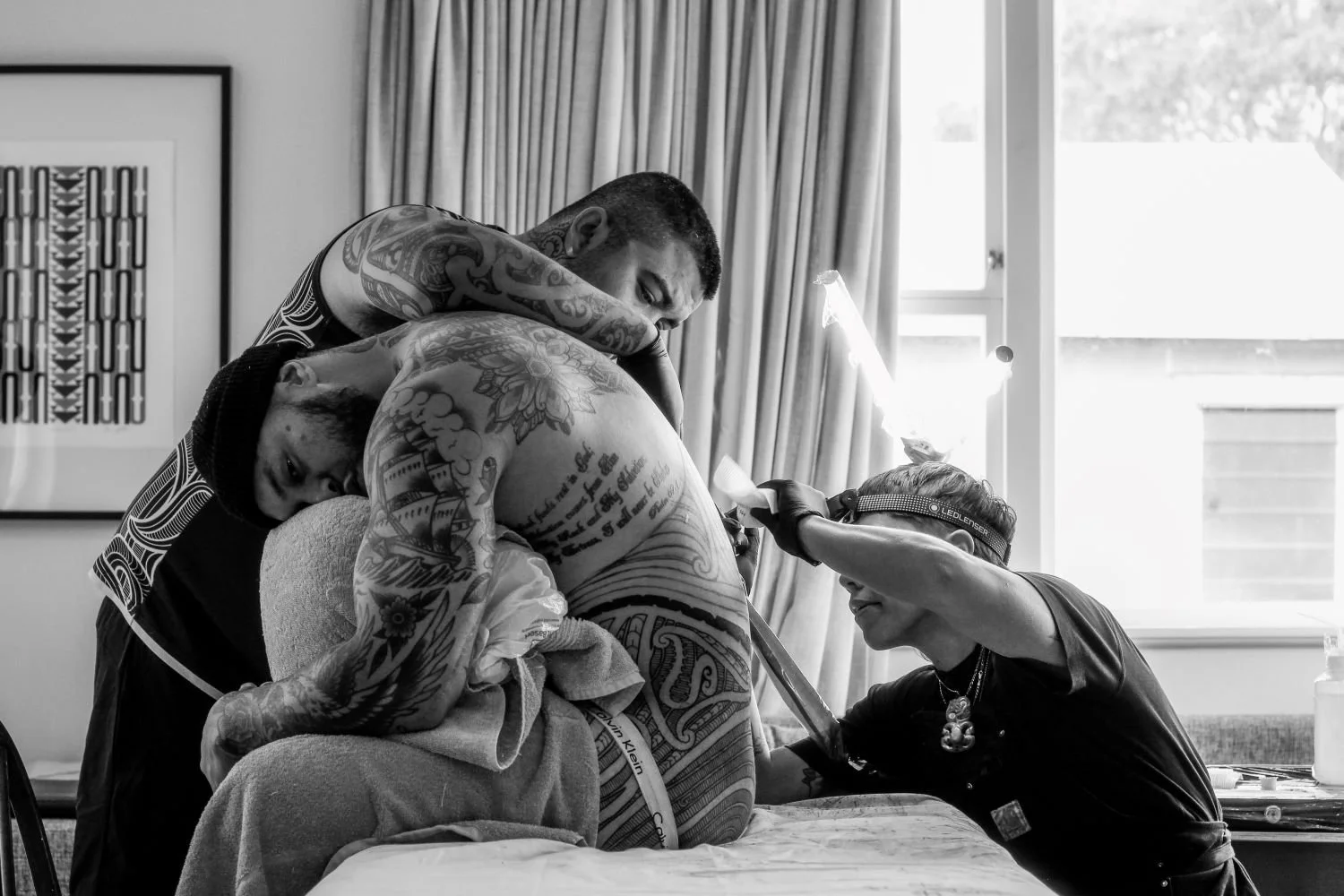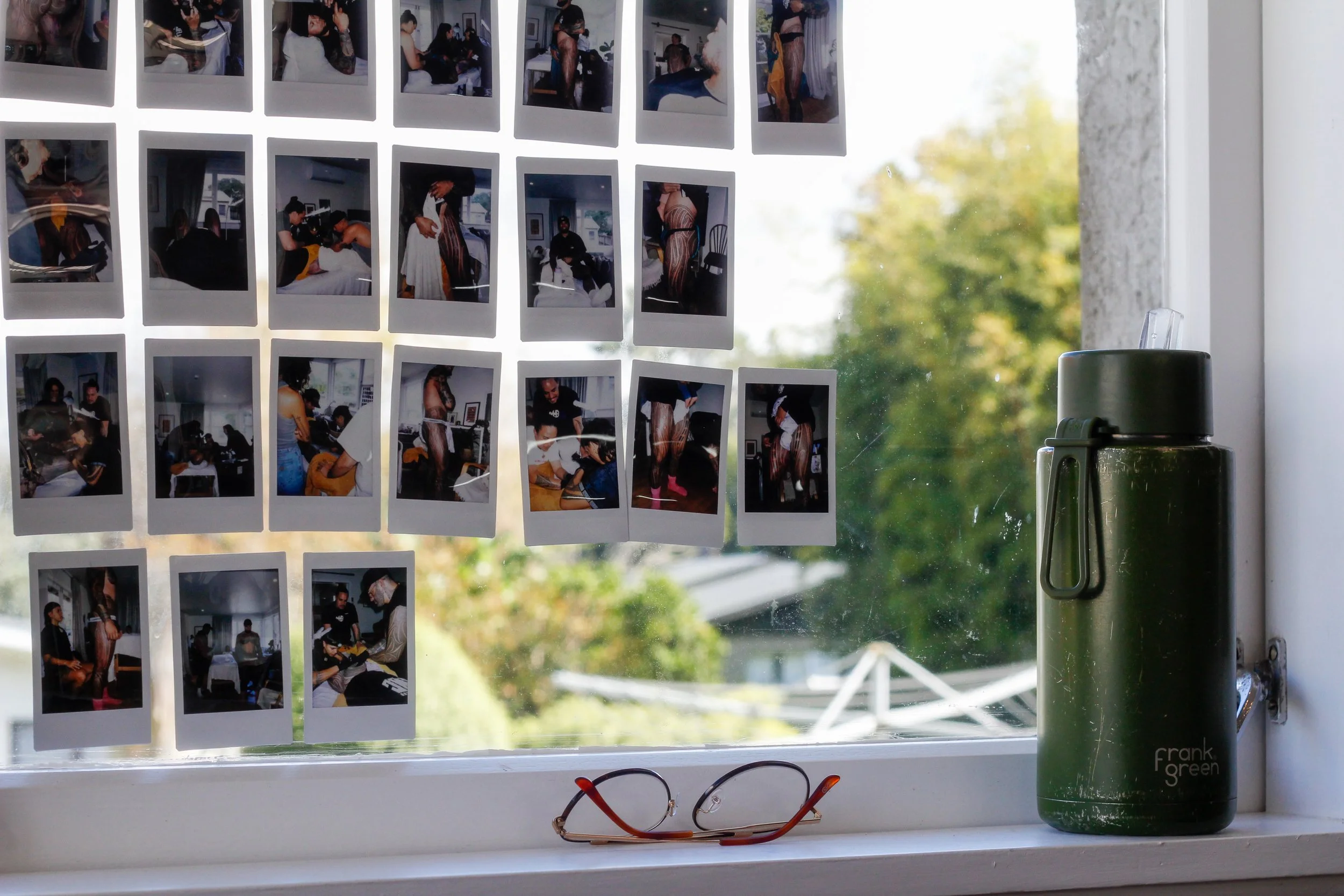Jarrod Tua shares his pūhoro journey
It’s been over a year since my husband Jarrod received his pūhoro in our whare in Kelston, from tā moko artist Flows by Rau — my sister Fern.
During the pūhoro wānanga in March 2024, I picked up my camera for the first time in years. It felt important to capture these moments through my lens — an opportunity to reconnect with my eye, my aesthetic, in my own home with my whānau.
The images have been sitting with me ever since. Over a year later, it feels like the right time to share them. I sat down with Jarrod to reflect on the experience, the journey, and everything the pūhoro has come to mean to him.
His words — raw and unfiltered — are shared here alongside my images.
Do you identify as an urban Māori?
Yes.
Why do you identify as an urban Māori?
My whakapapa lineage is to the Far North, Ngāti Kahu ki Whangaroa. But I was born and raised here in Tāmaki. Born in Middlemore Hospital. I went to primary, intermediate and college in Auckland. I played all my sports in Auckland, all my friends are in Auckland, my whānau.
I consider myself as a city slicker or an Aucklander. Every time I went back up north to where I'm from, we were labelled by my whānau and cousins up there. We had a different dress style or dress code to the ones up north. We spoke differently, different accents, if you would. Our whole demeanour was just city—you know, we were just city kids. Auckland hard.
We went to kura Māori. My parents took us out of the primary unit in the mainstream and put us into a reo unit, me and my brother, to try and get us on that pathway. It was different from all our other cousins who were in mainstream schools. I consider that an urban Māori.
What was it like being called a city slicker?
I liked being called a city slicker. I like Auckland. As much as people hate on Auckland and say, ‘I can't wait to leave this place’, I really appreciate what Auckland has done for me and my whānau and what it continues to do. So I have a really strong presence or footing for Tāmaki. I really love what Auckland has to offer.
What does the term ‘urban Māori’ mean to you?
The revolutionised Māori, in terms of using some of the technologies and what we have here in Auckland compared to a rural area with their set tikanga of wherever that rohe belongs to. I feel in Tāmaki, we have evolving respect for culture. As opposed to if you were to go home, it’s just straight Māori, straight tikanga to your marae or your kawa from up wherever you’re from.
Whereas in Tāmaki, there’s so many different cultures, proud cultures living amongst Auckland. You’ve got a vast variety of cultures coming together, so I think urban means living amongst our whānau from abroad—the Polynesian countries, Chinese and Indian. But also knowing that Māori are the indigenous to this whenua.
I think urban means we allow other cultures to be a part of the whenua in Tāmaki. I think that’s the difference of being urban Māori—we share our culture.
Can you share a bit about how you grew up?
I grew up in a few places. We had a place out in East Auckland and then from East Auckland I think we were in the city for a bit and then we moved out south to Zelda Ave in Ōtara or Flatbush. Growing up out there was pretty cool.
We just had all the basic necessities—it was those typical go to school, play out on the street till the lights came on, then back inside for a shower and dinner and you repeat and go again.
We have a strong sporting whānau, it was just natural to be in a sports team and to follow a sports team. All your uncles and aunties were in sports teams. So that’s what it was, just following sports your whole childhood.
Hanging out with your cousins—we had a really strong connection to all our cousins. We all grew up together, hung out together, ate, slept together—everything was together.
Right up until you were 12, you start getting into those teenage years and you start making your own friends and your own circles and your sports teams.
My life was pretty tough in terms of—you never knew that you didn’t have a lot until you’d seen kids that had a lot. I guess that’s when it started to become harder, when you realise, ‘Oh sh*t, I didn’t have that or I didn’t get that.’ So your mindset starts to change a bit. It makes you want to have things and your goals change and your mindset changes.
I wanted to be something, or be someone, and have things that other people didn’t have.
About a year ago, you undertook a six-day wānanga to receive your pūhoro. What led you to that?
I went through a few tough patches prior to getting my pūhoro. A few lifestyle changes, mindset changes, belief changes. Knowing that receiving this six-day gift would change your mindset, change your whole being, your whole self. It would really stamp your mark.
What better way to do it than by starting this journey, and this process of receiving the pūhoro—not just for the looks or not just because it's cool to have one, but it was for starting a new life of how I want to be. That represents all my learnings prior to getting it done, and then being able to use all of those learnings of my past life and experiences, and going on a path of how I want to live.
How did you come to work with Fern?
It was a tohu. Fern is my sister-in-law. I always supported her becoming an artist. When I used to get my ink done by Tom Mcmillan, we had a wānanga about apprentices and how to get into tā moko. At the time he had an apprentice under him, which was Tristan Marler, who ended up being Fern’s kaiako, under their guidance at Sunset Tattoo. That was a cool story, being a part of leading her to that. She took the opportunity and became Flows by Rau.
When Fern did her first big piece on me—my left calf sleeve—I said, ‘When you’re ready for a pūhoro, man, I’ll be keen.’ At the time she was like, ‘Oh sh*t, I’ve only just started.’ I messaged Gordon at the time and locked in with him, made a booking. But then COVID happened, so it was like a tohu—‘not ready, it’s not your time.’
Then I underwent a whole lot of other stuff in terms of my businesses, my relationship, my kids. Some massive changes in terms of how I wanna be and live and act, and I had new goals. Then, yeah, I decided I’m gonna go to Fern. It’s the right thing. She started my left leg and ended up doing my right leg. It just made sense. It ended up being in the next five years, which still seems quite short for the amount of mahi that she’s done.
So I was her first pūhoro. I asked her again and she was fully keen. I didn’t think she believed it at the time. She was a little bit like, ‘Yeah, yeah, all good.’ And then it actually got closer and closer and she was like, ‘Holy f*ck, we’re doing this.’ And I just felt like I was ready too—mentally and physically. I know some people get it younger and whatnot, but I just felt like, ‘Yeah, I’ve undergone so much experiences in my life that I knew I was ready mentally for this gift.’
We basically booked the date at her mum and dad’s house. It was both our first time doing this wānanga, so even how we navigated through having people come through and how we started the day and ended the day—it just happened naturally and organically. We already knew how we wanted to be and feel throughout the week. It was an awesome experience. We started on the raperape and it just felt natural having Fern do it. I didn’t feel uncomfortable, I didn’t feel like she wouldn’t do a great job. I just knew her—it just felt right. And it being at home too…
What was it like to endure those six days?
Day one—obviously I was high off adrenaline and excitement, and the raperape felt pretty easy. I’m not foreign to getting moko or tattoos done so I knew what the feeling is. After my raperape was done, we ended up drawing my leg and I think we even got started on some outlining on the leg as well.
But then you quickly knew—the adrenaline wears, it goes away. And then you have a look at your leg and go, ‘sh*t… I’ve got f*cking five more days left of this’. You start seeing how much skin you have on your legs. You realise how big your legs are. All of those games start to play.
Fern was really good in terms of helping you reset your mind, always made you feel comfortable if you wanted a break. She never put pressure on you to carry on or toughen it through. I just put that on myself. I’ve always been like that—never folded to pain. I always endure as much as I can until the artist usually taps. So I had that sort of mindset, to make Fern’s job a lot easier. I didn’t want her to waste her hours or time.
Day two was all good. Day three, you’re like, f*ck I’m over this, you want it over. You keep looking down at your legs—I was just trying to complete each step at a time. I had to really dive into my own wānanga and whakaaro, reminding myself that this is what I wanted, and knowing that this will be one of the first pūhoro in my whānau up north that’s ever been done in consecutive days. This sort of stuff is foreign to my whānau up north. They don’t know much about this side of te ao Māori and why we do this.
That was a big driver for me—to know there is one in our whānau and it may inspire more of my cousins to take this journey on. Hopefully it breaks that cycle of colonisation down and they want to be a part of getting back to what our tīpuna used to look like, and the reasoning behind going through these processes. They would have had a lot of mana and status. To undergo something like this gives you that mana. It’s about overcoming and enduring something for a bigger cause.
This was me saying that I want to be a successful Māori businessman in this world and knowing that I have this on my kiri—it means I’m aligned with my ancestors.
What was it like physically? How did you manage the pain?
I felt that pain before on my existing tattoos, but this one was a bit different because obviously you’re going over open wounds, multiple times, you’re wiping. The pain is real.
It’s like a thousand wounds at once—like you’ve been cut a thousand times. Instead of running from the lines, I just lived every line. I think that’s what made it easier—living each line. Because it is painful—anyone that gets a tattoo, it’s painful. It’s like that saying—you gotta work hard to get something. I guess anyone that gets a tā moko or tattoo or a pūhoro knows that that’s the sacrifice that comes with getting something like that. So to receive something beautiful is to undergo pain. And there was a lot of pain.
There were days where my body was shutting down. You could only have ibuprofen for the swelling to bring it down. I guess you just have to keep going back into your mind. You don’t just want to receive it—you want to take it, you want to fully live it. I didn’t want to forget any line. I wanted to make sure that I knew every line on my body. And I feel like I do—I can remember each line, what I did to get through that section. So that helped me get through the pain.
The pain is unreal. I had multiple whānau that came through and they all received their pūhoro. One was a female who said this is probably the closest thing to giving birth. So for us tāne to find something that’s close to what women have to go through—that gave me motivation as well.
What was it like spiritually and emotionally?
It was quite conflicting because I come from a Christian background. I was baptised in a Christian faith, and I’ve always been strong in my Christian faith. I knew God brought me up to be who I am, and to make the decisions that I’ve made. So I knew this was him saying, ‘Learn your culture. Be proud.’
It was like, ‘Oh bro, I’ve got this.’ Having a strong faith, and then also having your ancestors behind you and your whānau—spiritually I was connected to myself. I was connected to everything, so it helped me get through.
I think I only cried once out of the six days and it wasn’t a massive cry—just some tears. ’Cause it was f*ckn painful that day. The emotions were high with so many of our whānau that were there.
It was good having the support of my whānau—my in-law whānau, they’re very supportive, bringing kai through. My wider whānau that came and supported. My friends. All of them bringing in their love, and their aroha, their mana to help get me through this journey.
Has anything changed for you since receiving your pūhoro?
I’ve understood that learning comes in all forms. I’ve learnt to trust and to be vulnerable. A knowing that you’re strong enough to get through anything. It’s made me realise—do the things you want to do. Do it well. Do it properly.
I’m pretty impatient. So it’s really trusting the process of things, and it may not come straight away, but it will come. I think that’s been the hardest thing for my whole life. I trust, but I don’t like the process.
For example—I wanted to take out loans and get a flash building and put a mean gym in. But I’ve had to grind from Kelston Westech, from a garage, to a place that was just put together last minute, to now being able to construct our first—I'm not gonna say it’s our last—but our first TYF gym to enjoy with our whānau. We have a big quote now in our building and it literally says: Number one rule—trust the process. And I feel like that applies to all of us in our life.
We’re so eager to move past the process. Sometimes people don’t like what the process looks like or how long it takes. But if we trust, if we truly believe—we’ll get there. It just may not be in the timeframe that we think we’re ready for.
What does your pūhoro mean for your identity?
I think my pūhoro is an urban pūhoro. You know, obviously it was done in Auckland. It wasn’t done at home. It was done by a female who’s not from where I’m from. She’s from the Coast. She’s also half Pākehā as well. So that alone shows how strong urban Māori are. We’ve already broken so many rules in terms of who is allowed to give these taonga. It’s no longer just men, or men from your iwi—we’ve challenged those things.
So my pūhoro represents that. It represents my sister-in-law, what she has to endure being a wahine in this space. What she has to fight for every day to be a moko artist in Tāmaki. It represents my whānau, my wider whānau. Then lastly, it just represents who I am. I feel like it flows well with my character. It’s a lot different to most pūhoro.
What’s it like, as a tāne mau pūhoro in Tāmaki Makaurau? Any highs or lows?
Most feedback I’ve gotten is beautiful. You know, they’re stunned. They’re always in awe of it. I’ve never had any negative feedback or I’ve never felt uncomfortable with anyone else looking me up and down. I think people respect me a lot—especially our Islander whānau—because that’s part of their cultures as well. So we have a connection with our Sāmoan whānau, our Tongan whānau.
You’re not a stranger to moko and tattoo art. Why is it important to you?
It’s just a part of where I was at the time of my life. Each tattoo represented that—whether I was playing league or pursuing something, like building. Or the fashion at the time that I was into. I think my whānau were put off about tattoos, and you could never get tattoos. So in my mind, I was just like, don’t tell me something I can’t do.
That was always my mindset—so if someone challenged me or said you couldn’t do that, it was the wrong thing to say to me. I always, always proved them wrong. I guess my tattoos represent that. Prove you can. And do whatever you want. Be you—whoever you want.
What’s your message to others who might be considering pūhoro?
If you’re ready, you will know. No one sits for six days in pain to look cool. I think once you’re connected to yourself and you know who you are and what you wanna be, the decision is easy. You’re literally taking on a role.
I was reading it in one of these books... but basically, in order for you to change your mindset of what you are or who you are, you’ve gotta do something drastic to change your character in order for you to live that way. And I guess for someone to get a pūhoro, you drastically have to change the way you are if you wanna wear this. So you’re fully taking on a role—and it comes with responsibilities.
What’s your role?
To be the best version of myself, my whānau and friends. To be an entrepreneur and achieve my goals whilst being Māori in every way that I can be. I may not be the most fluent te reo speaker, but I know I’m going to represent my culture the best that I can—in my lane.
My role is to be a great entrepreneur. Someone to inspire our communities and people. To be able to look after my family and look after me, and have all those things that I didn’t have as a kid. I already have so much, and it’s just like, ok—what more can I do? Yeah, I’m never satisfied, so I want to keep going. There’s nothing that’s gonna stop me from trying. So I guess my role is just not giving up.
What’s next for you?
Just execute and be excellent in everything I do. Perfecting the art of trusting the process. Once I have perfected that art, it’s like unlimited boundaries for me. The sky’s the limit.
What’s on the cards for you in terms of body art?
I want to finish my back. I don’t want to see any skin on my body other than my feet, my hands, my neck. So that will complete my full body suit. Every part plays a lesson and a journey for me. It’s like armour—you’re not complete unless your armour is complete.
Whāia ngā mahi o Rarohenga
Jarrod Tua Pūhoro Wānanga with Flows By Rau | March 2024 | Shot on Canon 60D, 50mm lens

